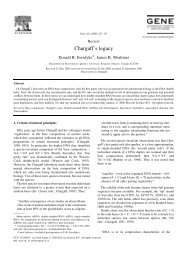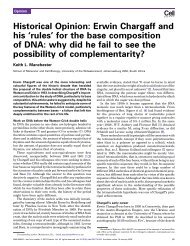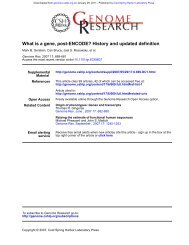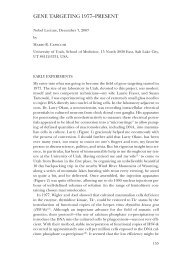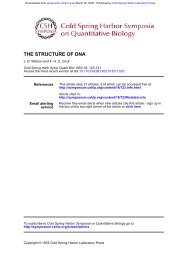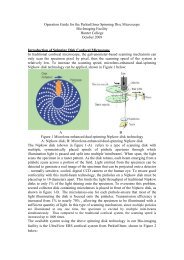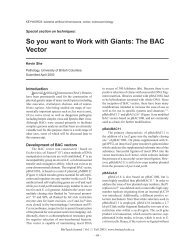Chemical specificity of nucleic acids and mechanism of ... - Biology
Chemical specificity of nucleic acids and mechanism of ... - Biology
Chemical specificity of nucleic acids and mechanism of ... - Biology
Create successful ePaper yourself
Turn your PDF publications into a flip-book with our unique Google optimized e-Paper software.
202 E. CHARGAFF" <strong>Chemical</strong> Specificity <strong>of</strong> Nucleic Acids <strong>and</strong> Mechanism <strong>of</strong> their Enzymatic Degradation [EXPERtF.NTIA VOL. VI]6~<br />
recognition <strong>of</strong> the composition <strong>of</strong> the substance, provided<br />
its molecular weight is known. The deviation <strong>of</strong><br />
the analytical results horn simple, integral proportions<br />
is without importance in that case, But this will not<br />
hold for high-molecular compounds in which variations<br />
in the proportions <strong>of</strong> their several components <strong>of</strong>ten<br />
will provide the sole indication <strong>of</strong> the occurrence <strong>of</strong><br />
different compounds.<br />
In attempting to formulate the problem with some<br />
exaggeration one could say: The validity <strong>of</strong> the identification<br />
<strong>of</strong> a substance by the methods <strong>of</strong> classical<br />
organic chemistry ends with the mixed melting point.<br />
When we deal with the extremely complex compounds<br />
<strong>of</strong> cellular origin, such as <strong>nucleic</strong> <strong>acids</strong>, proteins, or<br />
polysaccharides, a chemical comparison aiming at the<br />
determination <strong>of</strong> identity or difference must be based<br />
on the nature <strong>and</strong> the proportions <strong>of</strong> their constituents,<br />
on the sequence in which these constituents are arranged<br />
in the molecule, <strong>and</strong> on the type <strong>and</strong> the position<br />
<strong>of</strong> the linkages that hold them together. The<br />
smaller the number <strong>of</strong> components <strong>of</strong> such a highmolecular<br />
compound is, the greater is the difficulty <strong>of</strong><br />
a decision. The occurrence <strong>of</strong> a very large number <strong>of</strong><br />
different proteins was recognized early; no one to my<br />
knowledge ever attempted to postulate a protein as a<br />
compound composed <strong>of</strong> equimolar proportions <strong>of</strong> 18<br />
or 20 different amino <strong>acids</strong>. In addition, immunological<br />
investigations contributed very much to the recognition<br />
<strong>of</strong> the multiplicity <strong>of</strong> proteins. A decision between<br />
identity <strong>and</strong> difference becomes much more difficult<br />
when, as is the case with the <strong>nucleic</strong> <strong>acids</strong>, only few<br />
primary components are encountered. And when we<br />
finally come to high polymers, consisting <strong>of</strong> one<br />
component only, e. g. glycogen or starch, the characterization<br />
<strong>of</strong> the chemical <strong>specificity</strong> <strong>of</strong> such a compound<br />
becomes a very complicated <strong>and</strong> laborious task,<br />
While, therefore, the formulation <strong>of</strong> the tetranucleotide<br />
conception appeared explainable on historical<br />
grounds, it lacked an adequate experimental basis,<br />
especially as regards "thymo<strong>nucleic</strong> acid". Although<br />
only two <strong>nucleic</strong> <strong>acids</strong>, the desoxyribose <strong>nucleic</strong> acid<br />
<strong>of</strong> calf thymus <strong>and</strong> the ribose <strong>nucleic</strong> acid <strong>of</strong> yeast, had<br />
been examined analytically in some detail, all conclusions<br />
derived from the study <strong>of</strong> these substances<br />
were immediately extended to the entire realm <strong>of</strong><br />
nature; a jump <strong>of</strong> a boldness that should astound a<br />
circus acrobat. This went so far that in some publications<br />
the starting material for the so-called "thymo<strong>nucleic</strong><br />
acid" was not even mentioned or that it was<br />
not thymus at all, as may sometimes be gathered from<br />
the context, but, for instance, fish sperm or spleen. The<br />
animal species that had furnished the starting material<br />
<strong>of</strong>ten remained unspecified.<br />
Now the question arises: How different must complicated<br />
substances be, before we can recognize their<br />
difference? In the multiformity <strong>of</strong> its appearances<br />
nature can be primitive <strong>and</strong> it can be subtle. It is<br />
primitive in creating in a cell, such as the tubercle<br />
bacillus, a host <strong>of</strong> novel compounds, new fatty <strong>acids</strong>,<br />
alcohols, etc., that are nowhere else encountered.<br />
There, the recognition <strong>of</strong> chemical peculiarities is<br />
relatively easy. But in the case <strong>of</strong> the proteins <strong>and</strong><br />
<strong>nucleic</strong> <strong>acids</strong>, I believe, nature has acted most subtly;<br />
<strong>and</strong> the task facing us is much more difficult. There is<br />
nothing more dangerous in the natural sciences than<br />
to look for harmony, order, regularity, before the<br />
proper level is reached. The harmony <strong>of</strong> cellular life<br />
may well appear chaotic to us. The disgust for the<br />
amorphous, the ostensibly anomalous--an interesting<br />
problem in the psychology <strong>of</strong> science--has produced<br />
many theories that shrank gradually to hypotheses<br />
<strong>and</strong> then vanished.<br />
We must realize that minute changes in the <strong>nucleic</strong><br />
acid, e. g. the disappearance <strong>of</strong> one guanine molecule<br />
out <strong>of</strong> a hundred, could produce far-reaching changes<br />
in the geometry <strong>of</strong> the conjugated nucleoprotein; <strong>and</strong><br />
it is not impossible that rearrangements <strong>of</strong> this type<br />
are among the causes <strong>of</strong> the occurrence <strong>of</strong> mutations 1.<br />
The molecular weight <strong>of</strong> the pentose <strong>nucleic</strong> <strong>acids</strong>,<br />
especially <strong>of</strong> those from animal tissue cells, is not yet<br />
known; <strong>and</strong> the problem <strong>of</strong> their preparation <strong>and</strong><br />
homogeneity still is in a very sad state. But that the<br />
desoxypentose <strong>nucleic</strong> <strong>acids</strong>, prepared under as mild<br />
conditions as possible <strong>and</strong> with the avoidance <strong>of</strong><br />
enzymatic degradation, represent fibrous structures <strong>of</strong><br />
high molecular weight, has <strong>of</strong>ten been demonstrated.<br />
No agreement has as yet been achieved on the order <strong>of</strong><br />
magnitude <strong>of</strong> the molecular weight, since the interpretation<br />
<strong>of</strong> physical measurements <strong>of</strong> largely asymmetric<br />
m~lecules still presents very great difficulties.<br />
But regardless <strong>of</strong> whether the desoxyribo<strong>nucleic</strong> acid<br />
<strong>of</strong> calf thymus is considered as consisting <strong>of</strong> elementary<br />
units <strong>of</strong> about 35,000 which tend to associate to larger<br />
structures ~ or whether it is regarded as a true macromolecule<br />
<strong>of</strong> a molecular weight around 820,0008, the<br />
fact remains that the desoxypentose <strong>nucleic</strong> <strong>acids</strong> are<br />
high-molecular substances which in size resemble, or<br />
even surpass, the proteins. It is quite possible that<br />
there exists a critical range <strong>of</strong> molecular weights above<br />
which two different cells witl prove unable to synthesize<br />
completely identical substances. The enormous<br />
number <strong>of</strong> diverse proteins may be cited as an example.<br />
Duo non /aciunt idem is, with respect to cellular<br />
chemistry, perhaps, an improved version <strong>of</strong> the old<br />
proverb.<br />
III. Purpose<br />
We started in our work from the assumption that<br />
the <strong>nucleic</strong> <strong>acids</strong> were complicated <strong>and</strong> intricate high-<br />
1 For additional remarks on this probtem, compare E.CHARGAFF,<br />
in Nucleic Acids <strong>and</strong> Nucleoproteins, Cold Spring Harbor Syrup.<br />
Quant. Biol., I~, o8 (Cold Spring Harbor, N,Y., 1947).<br />
2 I~.HAMMARSTEN, Acta reed. St<strong>and</strong>., Suppl. 196, 684 (1947).-<br />
G. JUNGNI~R, I. JUNC, NER, <strong>and</strong> L.-G.ALLGI~N, Nature 163, 849 (19.19).<br />
3 R.CEclL <strong>and</strong> A, G.OGSTON, J. Chem. Soc. 138~ (1948).



